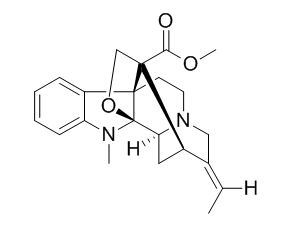Pseudoakuammigine
Pseudoakuammigine exhibits anti-inflammatory and analgesic actions, the analgesic actions are mediated via interaction with opioid receptors.
Inquire / Order:
manager@chemfaces.com
Technical Inquiries:
service@chemfaces.com
Tel:
+86-27-84237783
Fax:
+86-27-84254680
Address:
1 Building, No. 83, CheCheng Rd., Wuhan Economic and Technological Development Zone, Wuhan, Hubei 430056, PRC
Providing storage is as stated on the product vial and the vial is kept tightly sealed, the product can be stored for up to
24 months(2-8C).
Wherever possible, you should prepare and use solutions on the same day. However, if you need to make up stock solutions in advance, we recommend that you store the solution as aliquots in tightly sealed vials at -20C. Generally, these will be useable for up to two weeks. Before use, and prior to opening the vial we recommend that you allow your product to equilibrate to room temperature for at least 1 hour.
Need more advice on solubility, usage and handling? Please email to: service@chemfaces.com
The packaging of the product may have turned upside down during transportation, resulting in the natural compounds adhering to the neck or cap of the vial. take the vial out of its packaging and gently shake to let the compounds fall to the bottom of the vial. for liquid products, centrifuge at 200-500 RPM to gather the liquid at the bottom of the vial. try to avoid loss or contamination during handling.
Molecules2020, 25(4):892
Korean Journal of Pharmacognosy.2015, 46(4):352-364
J Cachexia Sarcopenia Muscle.2022, 13(6):3149-3162.
Chemistr of plant2016, 2016021195
Front Pharmacol.2016, 7:460
Malaysian J of Fundamental and Applied Sciences 2018, 14(3):368-373
Nutrients.2021, 13(10):3414.
Horticulturae2023, 9(2), 213.
Life Sci.2023, 317:121458.
Evid Based Complement Alternat Med.2021, 8855980.
Related and Featured Products
Eur J Pharmacol. 1998 May 29;350(1):101-8.
Opioid activity of alkaloids extracted from Picralima nitida (fam. Apocynaceae).[Pubmed:
9683021]
Extracts of the seeds of Picralima nitida (fam. Apocynaceae) have been reported to have opioid analgesic activity.
METHODS AND RESULTS:
In this investigation, isolated tissue bioassays and radioligand binding assays have been used to determine the opioid activity of five alkaloids--akuammidine, akuammine, akuammicine, akuammigine and Pseudoakuammigine--extracted from the seeds of P. nitida. Akuammidine showed a preference for mu-opioid binding sites with Ki values of 0.6, 2.4 and 8.6 microM at mu-, delta- and kappa-opioid binding sites, respectively. The agonist actions of akuammidine in the mouse-isolated vas deferens were antagonised by naloxone and the mu-opioid receptor selective antagonist D-Phe-Cys-Tyr-D-Trp-Orn-Thr-Pen-Thr-NH2 (CTOP) confirming an action at mu-opioid receptors. In contrast, akuammine also showed highest affinity for mu-opioid binding sites (Ki 0.5 microM) but was an antagonist at mu-opioid receptors with a pK(B) of 5.7 against the selective mu-opioid receptor agonist [D-Ala2,MePhe4,Gly-ol5]enkephalin (DAMGO). Akuammicine has the highest affinity for kappa-opioid binding sites (Ki 0.2 microM) and was a full agonist at kappa-opioid receptors in the guinea pig ileum preparation but a partial kappa-opioid receptor agonist in the vasa deferentia of the mouse and the rabbit. Akuammigine and Pseudoakuammigine showed little or no efficacy in the opioid bioassays. None of the alkaloids had significant activity for opioid receptor-like binding sites (ORL1-binding sites) with Ki values >> 10 microM.
CONCLUSIONS:
These data show that some alkaloids extracted from the medicinal plant P. nitida possess varying degrees of agonist and antagonist activity at opioid receptors but possess neither high affinity nor selectivity for mu-, delta- or kappa-opioid receptors or the ORL1-receptor.
Curr Med Chem. 2003 Sep;10(18):1891-915.
Current progress in the chemistry and pharmacology of akuammiline alkaloids.[Pubmed:
12871110]
METHODS AND RESULTS:
Akuammiline alkaloids are a family of monoterpene indole alkaloids of renewed medicinal interest.
These bases act as ligands for a heterogeneous group of molecular targets and, consequently, display a wide variety of pharmacological activities. For example, Pseudoakuammigine (2) exhibits opioid activity in vivo, echitamine (4) has been reported to have promising cytotoxic activity, and corymine (121) behaves as an antagonist of the glycine receptor. Oddly enough, these alkaloids have not raised enough interest in the organic synthesis community, remaining inaccessible; even the entry to their pentacyclic framework continues elusive. Recently, several akuammiline bases have been isolated and identified including bisindole alkaloids, such as vingramine (103) or rausutrine (110), which incorporate akuammiline-type subunits.
CONCLUSIONS:
This review covers the advances in the chemistry and pharmacology of akuammiline alkaloids reported within the last ten years.
J Ethnopharmacol. 2002 Jun;81(1):73-9.
Pseudoakuammigine, an alkaloid from Picralima nitida seeds, has anti-inflammatory and analgesic actions in rats.[Pubmed:
12020930]
METHODS AND RESULTS:
Pseudoakuammigine, an alkaloid from Picralima nitida seed extract was investigated for anti-inflammatory and analgesic actions using the carrageenan-induced rat paw oedema and the rat tail flick. The alkaloid, at 1.0, 5.0 and 50 mgkg(-1)(,) dose-dependently inhibited the mean maximal paw swelling attained during 6 h to 78.2+/-2.1, 74.7+/-4.3 and 59.5+/-2.3% of the mean control value respectively when administered p.o. 1 h before induction of oedema. At the same dose levels, the total paw swelling over the 6-h period was also significantly (P<0.05) reduced to 83.2+/-9.7, 73.0+/-5.0 and 55.8+/-8.3% of the mean control response respectively. When administered after induction of oedema, psi-akuammigine (5.0 mgkg(-1)) significantly (P<0.05) reduced established rat paw swelling to 82.8+/-4.6% of the control response after 5 h. As an analgesic, psi-akuammigine was 3.5 and 1.6 times less potent than morphine and indomethacin respectively. The ED(50) values were Morphine (2.9 microM), psi-akuammigine (10 microM) and indomethacin (6.3 microM). Naloxone (1.0 mgkg(-1)) significantly (P<0.05) antagonised the analgesic action of the alkaloid by 35.8+/-6.8%. Pseudo-akuammigine therefore exhibits anti-inflammatory and analgesic actions.
CONCLUSIONS:
The analgesic actions are mediated via interaction with opioid receptors.



